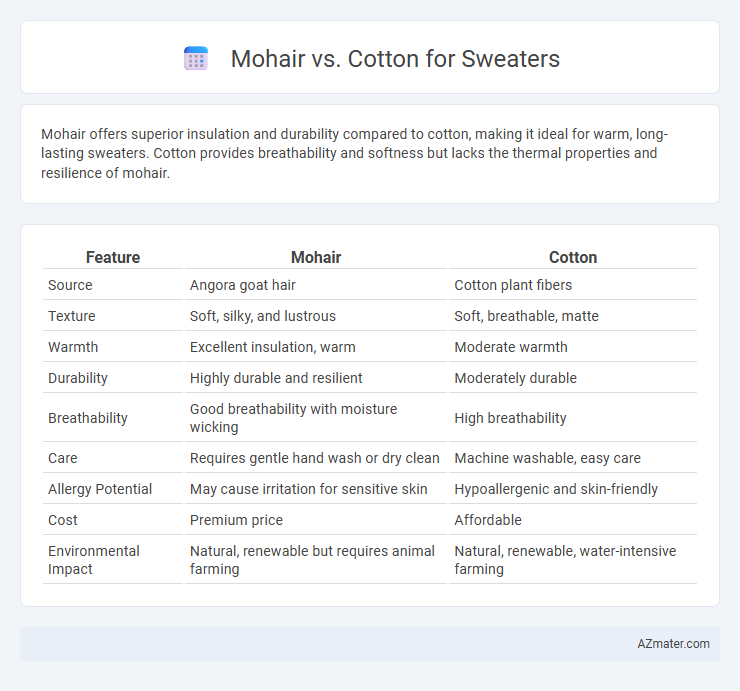Mohair offers superior insulation and durability compared to cotton, making it ideal for warm, long-lasting sweaters. Cotton provides breathability and softness but lacks the thermal properties and resilience of mohair.
Table of Comparison
| Feature | Mohair | Cotton |
|---|---|---|
| Source | Angora goat hair | Cotton plant fibers |
| Texture | Soft, silky, and lustrous | Soft, breathable, matte |
| Warmth | Excellent insulation, warm | Moderate warmth |
| Durability | Highly durable and resilient | Moderately durable |
| Breathability | Good breathability with moisture wicking | High breathability |
| Care | Requires gentle hand wash or dry clean | Machine washable, easy care |
| Allergy Potential | May cause irritation for sensitive skin | Hypoallergenic and skin-friendly |
| Cost | Premium price | Affordable |
| Environmental Impact | Natural, renewable but requires animal farming | Natural, renewable, water-intensive farming |
Introduction to Mohair and Cotton Sweaters
Mohair sweaters, made from the silky hair of the Angora goat, offer exceptional softness, warmth, and a natural sheen that sets them apart from cotton sweaters. Cotton sweaters, crafted from natural cotton fibers, provide breathability, durability, and easy maintenance, making them ideal for everyday wear. The distinct fiber properties influence the texture, insulation, and overall comfort of each sweater type, catering to different climate needs and style preferences.
Key Differences Between Mohair and Cotton
Mohair fibers, derived from the Angora goat, are known for their lightweight, silky texture and superior insulating properties, making mohair sweaters exceptionally warm yet breathable. In contrast, cotton is a natural plant-based fiber prized for its softness, moisture absorption, and durability, providing a cooler and more breathable option suitable for warmer climates. Mohair's natural sheen and elasticity differ markedly from cotton's matte finish and structure, affecting the sweater's appearance and stretchability.
Mohair Sweater: Pros and Cons
Mohair sweaters offer exceptional softness, natural insulation, and a luxurious sheen, making them ideal for warmth and style during colder months. The fiber's durability and moisture-wicking properties enhance comfort, but mohair can be more expensive and requires delicate care to prevent matting or shedding. Compared to cotton, mohair provides superior warmth and a unique texture but may cause itchiness in sensitive skin and demands more careful maintenance.
Cotton Sweater: Pros and Cons
Cotton sweaters offer breathability, softness, and hypoallergenic properties, making them ideal for sensitive skin and warmer climates. They tend to be durable and easy to care for but can lack the insulating warmth and moisture-wicking capabilities found in mohair fibers. Cotton sweaters may also stretch out or shrink if not handled properly during washing and drying.
Warmth and Insulation Comparison
Mohair fibers, derived from Angora goats, provide superior warmth and insulation compared to cotton due to their natural loft and moisture-wicking properties. Cotton, being a plant-based fiber, tends to retain moisture and loses insulating ability when wet, making it less effective in cold conditions. Sweaters made from mohair offer better thermal regulation and lightweight warmth, ideal for maintaining body heat in colder climates.
Comfort and Texture: Mohair vs Cotton
Mohair sweaters offer a luxurious softness and a silky texture, providing exceptional warmth without heavy weight, making them ideal for cozy comfort. Cotton sweaters feel breathable and smooth against the skin, offering a lightweight, natural fabric that excels in moisture absorption and everyday wear. While mohair delivers a plush, insulating touch, cotton provides a cool, airy feel, catering to different preferences in texture and seasonal comfort.
Durability and Longevity
Mohair fibers, derived from the Angora goat, exhibit superior durability compared to cotton due to their natural resilience and resistance to pilling, making them ideal for long-lasting sweaters. Cotton, while breathable and soft, tends to wear out faster and lose shape over time due to fiber breakage and shrinkage. Sweaters made from mohair maintain their structural integrity and appearance longer, enhancing their lifespan and value in cold-weather apparel.
Care and Maintenance Requirements
Mohair sweaters require gentle hand washing or dry cleaning to preserve fiber softness and prevent shedding, while cotton sweaters can withstand regular machine washing and drying with minimal risk of damage. Mohair's delicate fibers are prone to felting and shrinkage if exposed to harsh agitation or high temperatures, demanding careful storage to avoid moth damage. Cotton fibers offer greater durability and ease of care, making cotton sweaters a low-maintenance option suitable for frequent wear and laundering.
Environmental Impact: Mohair vs Cotton
Mohair production has a lower water footprint compared to cotton, requiring significantly less irrigation, which reduces water stress in arid regions. Cotton cultivation relies heavily on pesticides and fertilizers, contributing to soil degradation and pollution, whereas mohair farming promotes sustainable grazing practices that enhance soil health. The biodegradability and renewable nature of both fibers support eco-friendly fashion, but mohair's minimal chemical usage and efficient land use offer a more environmentally responsible option for sweaters.
Choosing the Best Material for Your Sweater
Mohair offers superior warmth, softness, and durability compared to cotton, making it ideal for cozy, long-lasting sweaters. Cotton excels in breathability and moisture-wicking, perfect for lightweight, comfortable sweaters in milder climates. Weigh factors like climate, desired texture, and maintenance when choosing between mohair and cotton for your sweater.

Infographic: Mohair vs Cotton for Sweater
 azmater.com
azmater.com